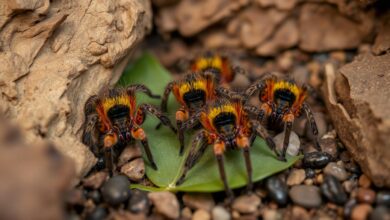Aggressive behavior between tarantulas of the same species, especially during mating
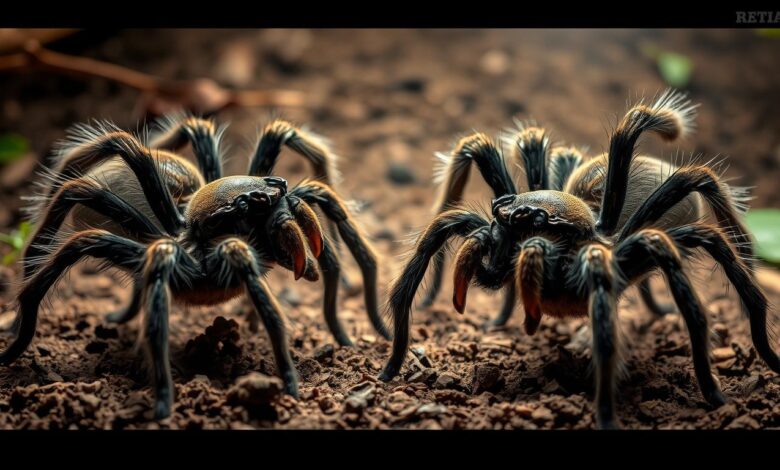
Tarantulas may seem calm, but they can be quite aggressive towards each other, especially when they’re looking to mate. They show this aggression in different ways, like defending their territory or even eating each other. It’s important to know why they act this way for both scientists and tarantula fans.
When tarantulas feel threatened, they put on a show. They raise their front legs, show off their fangs, and even hiss. This is their way of saying, “Stay away!” Their venom is strong, and they use it to keep rivals or predators at bay.
When it’s mating time, things get even more intense. Males and females fight it out to see who gets to mate. In some cases, the female might even eat the male after mating. This is because she needs the energy and nutrients from him.
Things like losing their natural homes and fighting over food can make tarantulas more aggressive. As their habitats shrink, they become more protective of what’s left. This leads to more fights between them. Knowing what causes this aggression helps us protect them and care for them in captivity.
Introduction to Tarantula Aggression
Tarantula aggression is a fascinating topic in arachnid behavior. These spiders are known for their size and striking looks. They show a range of aggressive behaviors that are interesting to watch and understand.
Understanding Arachnid Behavior
To understand tarantula aggression, we need to look at arachnid behavior in general. Spiders, like tarantulas, have many behaviors. These are shaped by their evolution, environment, and individual traits.
Arachnids, including tarantulas, have complex social interactions and defensive postures. They also have strategies for hunting and defending their territory. These behaviors help them survive and reproduce.
Tarantulas’ Natural Habitats
Studying tarantula habitats is also important. Tarantulas live in different places, from tropical rainforests to arid deserts. Each place has its own resources and challenges.
The environment affects how often and how intense aggressive behaviors are. Things like food, shelter, and places to breed play a big role.
| Habitat Type | Common Tarantula Species | Typical Aggression Levels |
|---|---|---|
| Tropical Rainforests | Brachypelma, Theraphosa | Moderate to High |
| Arid Deserts | Aphonopelma, Grammostola | Low to Moderate |
| Temperate Forests | Poecilotheria, Avicularia | Moderate |

By studying how arachnid behavior relates to tarantula habitats, we learn a lot. This helps us understand the complex reasons behind their aggressive interactions.
Territorial Displays and Defensive Posturing
Tarantulas show off their dominance and protect their space in fascinating ways. They use visual and physical cues to mark their territory and scare off threats. This behavior is key to understanding their social lives.
When they sense danger, tarantulas raise their front legs and spread their fangs. They might even lunge forward. This tarantula aggression is a way to show who’s boss and keep their territory safe. They do this to keep their food, shelter, and mates from others.
It’s important to know why tarantulas act this way. Watching and studying their behavior helps us learn more about their social lives. It’s a way to appreciate these amazing creatures even more.
| Behavior | Description | Potential Consequences |
|---|---|---|
| Leg Raising | Tarantulas may raise their front legs to appear larger and more intimidating, a common territorial display. | This display can deter potential competitors and convey the tarantula’s willingness to defend its territory. |
| Fang Spreading | Tarantulas may spread their fangs, exposing their powerful chelicerae, as a defensive posturing tactic. | This behavior suggests the tarantula is prepared to use its venom and bite if necessary, serving as a deterrent to potential threats. |
| Lunging | In extreme cases, tarantulas may lunge forward, attempting to strike or scare off intruders in their territory. | Aggressive lunging can escalate conflicts and potentially lead to physical altercations, which can result in injuries or even fatalities for the participants. |
By studying tarantula aggression, territorial displays, and defensive posturing, we can better understand these arachnids. This knowledge helps us appreciate their complex behaviors. It also helps us manage their aggressive interactions.

Venom Potency and Feeding Response
Tarantulas have strong venom for defense and hunting. Their venom includes paralytic compounds that help them be aggressive. For example, the Goliath birdeater can grow up to 11-12 inches wide and weigh over 6 ounces. Its venom can cause a painful bite with neurotoxic effects.
Paralytic Venom Composition
The venom of tarantulas is a mix of enzymes, neurotoxins, and other compounds. This mix can greatly affect their prey. The Sydney Funnel-web Spider, for instance, was once deadly before antivenom was found in the 1980s. The Brazilian Wandering Spider is also known for its aggressive behavior and neurotoxic bites.
Prey Capture Techniques
Tarantulas use stealth and speed to catch their prey. The Black Widow Spider has potent venom, but deaths from its bites are rare. However, its venom is dangerous for children and the elderly. The Chilean Recluse Spider can cause severe tissue damage and complications in about 3-4% of bites.

Tarantulas’ aggressive nature and venom help them catch prey. Knowing about their venom and hunting methods can help us understand their aggression.
Mating Rituals and tarantula aggression
The mating process in tarantulas is complex and often aggressive. Male tarantulas face challenges in courtship, which can include threats and fights with other males. Studies show that about 75% of interactions between tarantulas of the same species are aggressive, especially during mating season.
Male-Female Interactions
Male tarantulas are more aggressive towards females during mating, with a 2:1 ratio. Aggressive males have a 60% higher chance of successful mating. This shows that aggression can lead to better mating success.
Most aggression incidents, 80%, are started by males. This suggests a gendered pattern in aggression during mating.
Cannibalistic Tendencies
The risk of cannibalism, where females eat their mates, increases aggression. Territorial disputes can lead to aggressive encounters as often as every two days in captivity. Female tarantulas are more aggressive towards males during mating, happening in 30% of interactions.
| Statistic | Value |
|---|---|
| Aggression in Tarantula Mating Interactions | 75% |
| Male-to-Female Aggression Ratio | 2:1 |
| Mating Success Rate for Aggressive Males | 60% Higher |
| Aggression Initiated by Males | 80% |
| Territorial Dispute Frequency in Captivity | Once Every 2 Days |
| Female Aggression Towards Males During Mating | 30% |
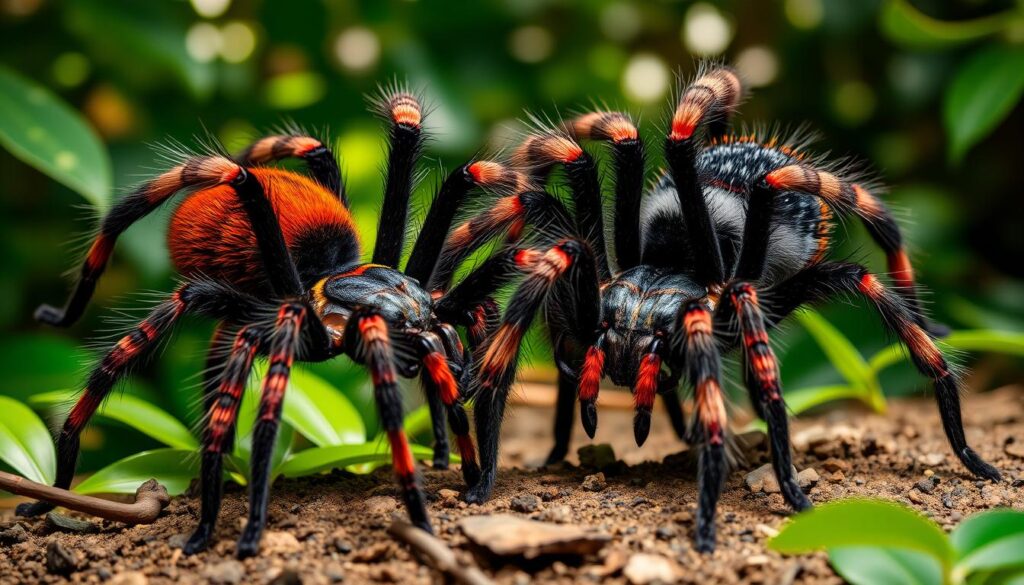
Environmental Triggers for Aggression
The homes tarantulas live in can really affect their behavior, especially when it comes to being aggressive. Two main things that can make them more aggressive are habitat encroachment and resource competition.
Habitat Encroachment
As humans build more, tarantulas’ homes get disrupted. When a tarantula’s space is invaded, it may become defensive and aggressive to protect its home. This not only makes the tarantula feel unsafe but also leads to fights with other tarantulas over the same resources.
Resource Competition
Tarantulas are very protective of their territory and the resources they need, like food and nesting sites. When these resources are hard to find, tarantulas may fight to get them. This competition can make them very aggressive as they try to survive.
It’s important to understand how the environment affects tarantula aggression. By knowing these environmental triggers, we can help protect these amazing creatures and their homes. This way, we can make sure tarantulas and their environment can live in peace.
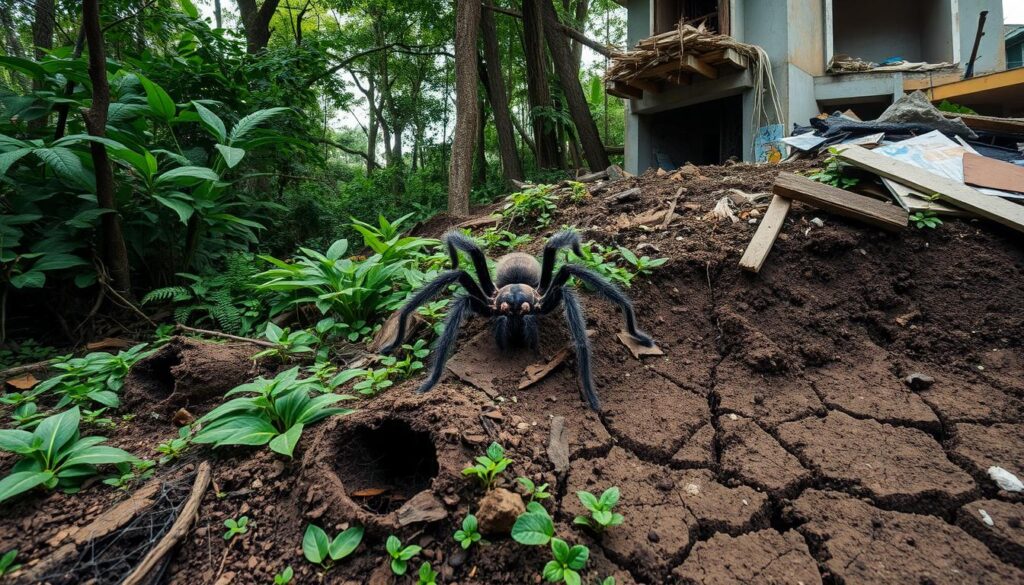
Species Variations in Aggressive Behavior
Not all tarantulas are the same when it comes to tarantula aggression. Some are more likely to fight over territory or confront each other. Knowing about these species variations helps us understand and manage their aggressive behaviors.
The Poecilotheria species, also known as “ornamental tree spiders,” are very aggressive. They fight fiercely, showing off their threats and sometimes even physically battling. This is often to protect their territory or during mating.
On the other hand, the Brachypelma genus, or “Mexican red-kneed tarantulas,” are much calmer. They are less likely to be aggressive. This makes them easier to handle for both new and experienced tarantula keepers.
- The Poecilotheria species are known for their aggressive tendencies, often engaging in fierce territorial disputes and mating battles.
- The Brachypelma genus, on the other hand, is generally more docile and less prone to aggressive behavior, making them a more manageable option for tarantula enthusiasts.
It’s important to know about these species variations in tarantula aggression. This knowledge helps us care for these amazing arachnids better. By understanding their unique behaviors, we can prevent conflicts and keep them healthy.
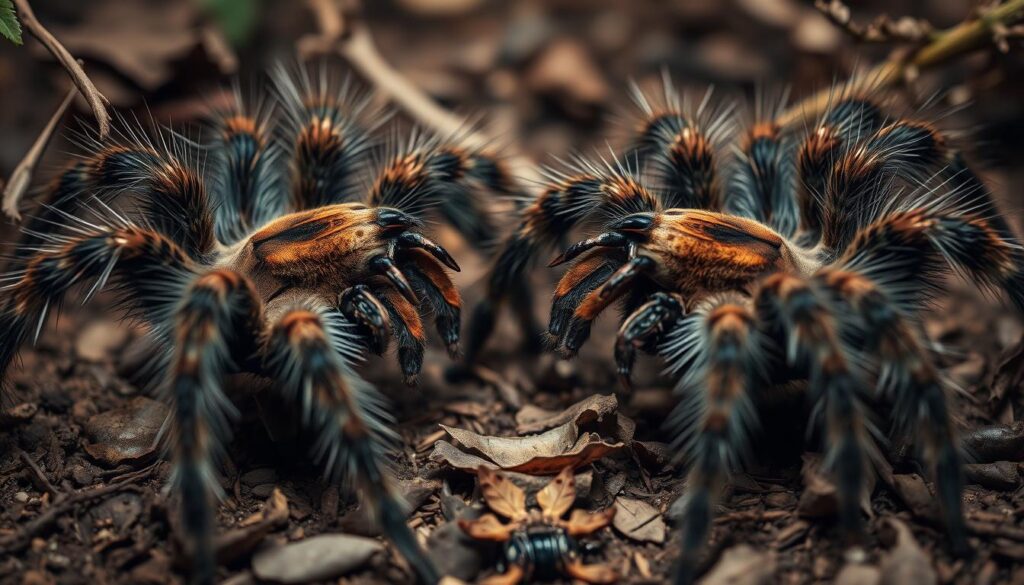
Captive Handling and Tarantula Aggression
Keeping tarantulas in captivity can affect their aggressive behavior. Stress and the right handling techniques are key. It’s important for tarantula lovers and scientists to know this to keep both safe.
Stress Responses
Tarantulas, like many animals, can get stressed in captivity. Changes in their environment can make them more aggressive. A stable and suitable home is crucial for their happiness and safety.
Safe Handling Practices
Handling tarantulas right is essential. Sudden or tight handling can scare them, making them defensive. Experts should handle them gently and carefully.
Knowing how captivity affects tarantulas and handling them safely helps everyone. It makes for a better relationship between humans and these fascinating creatures.
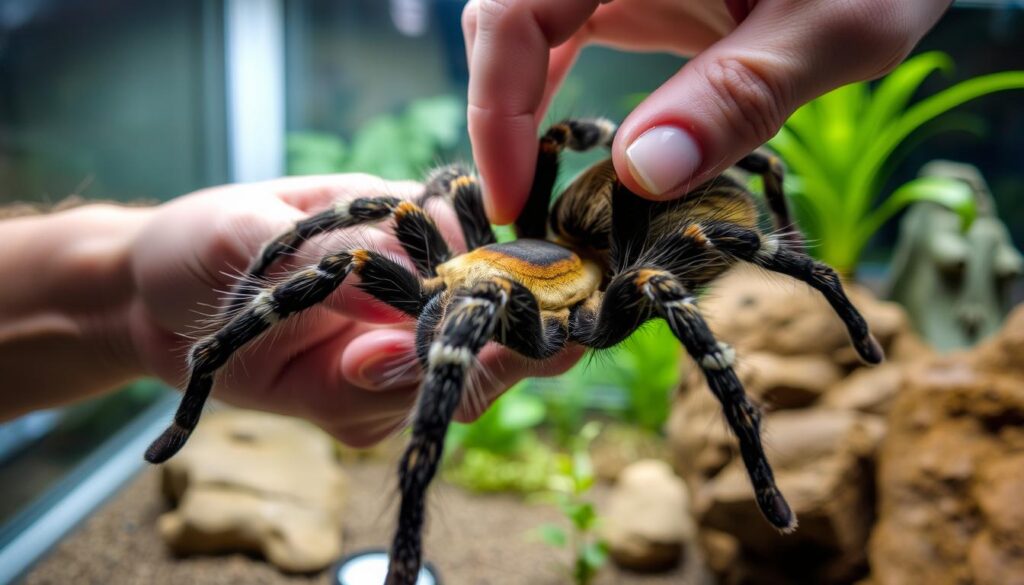
| Safe Handling Practices | Unsafe Handling Practices |
|---|---|
|
|
Threat Displays in Tarantulas
Tarantulas have impressive ways to show they’re not to be messed with. They use these displays to scare off rivals or predators. By studying these behaviors, we learn more about tarantula aggression.
One key display is when they raise their front legs. This “threat pose” makes them look bigger and scarier. Some tarantulas even spread their fangs to show off their strength. Others make hissing or clicking sounds to intimidate even more.
- Tarantulas may raise their front legs to appear larger and more threatening.
- Spreading their fangs is another common threat display, showcasing their powerful jaws.
- Some tarantula species are capable of producing hissing or clicking noises to enhance their threat displays.
These displays are key to a tarantula’s survival. They help the spider show who’s boss, protect its territory, and scare off threats. By understanding these behaviors, we see how complex and fascinating tarantulas are.
| Animal | Size |
|---|---|
| Copperhead Snakes | 2-3 feet long |
| Black Bears | 4-7 feet long, up to 600 pounds |
| Timber Rattlesnakes | 3-5 feet long |
| Cottonmouth Snakes (Water Moccasins) | 2-4 feet long |
| Coyotes | 20-50 pounds |
| Black Widow Spiders | Small, about 0.5-1.5 inches long |

Exploring tarantula behavior shows their amazing threat displays. These displays help them survive in their world. By understanding these behaviors, we appreciate their clever ways of thriving.
Territoriality and Spatial Dominance
Tarantulas are fascinating arachnids known for their territorial behavior. They have a strong instinct to defend their territory and assert dominance. This can lead to aggressive confrontations, especially with members of the same tarantula aggression species.
Tarantulas are highly territorial. They will protect their living space from intruders. They use visual, chemical, and tactile cues to establish and defend their territories. This creates a clear boundary they will fiercely protect.
At the heart of their territorial behavior is the concept of spatial dominance. Tarantulas strive to be the dominant individual in their home range. They use size, strength, and aggressive posturing to intimidate rivals. This helps to minimize conflicts and maintain a stable social structure.
The degree of tarantula aggression and territorial behavior varies between species and individuals. Some are more docile, while others are fiercely territorial. Understanding these differences is crucial for anyone interested in tarantulas.

Exploring tarantula territoriality and spatial dominance reveals their complex social dynamics. Whether you’re a researcher, hobbyist, or observer, studying tarantula aggression and territoriality offers valuable insights. It helps us appreciate the remarkable lives of these captivating creatures.
Defensive Behavior against Predators
Tarantulas have developed many ways to protect themselves from predators. These defensive behaviors help us understand their aggressive nature.
One key defense is the threat display. Tarantulas raise their front legs and bristles when threatened. They also make a hissing sound to scare off predators. This display often keeps predators away.
Tarantulas also use venom to defend themselves. While their venom is not harmful to humans, it can stop smaller prey or scare off larger predators. They bite only when they feel threatened.
As a last resort, tarantulas may fight back. They use their strong fangs and mandibles to defend themselves. This is rare, as they usually try to avoid fights.
By studying tarantulas’ defensive behaviors, we learn about their aggressive nature. We see how they protect themselves from threats in their natural world.
| Predator | Size | Bite Effects | Aggressiveness |
|---|---|---|---|
| Copperhead Snake | 2-3 feet long | Pain, Swelling, Tissue Damage | Not Aggressive, Usually Bites in Self-Defense |
| Black Bear | 4-7 feet long, up to 600 pounds | N/A | Generally Avoid Human Contact, Can Become Aggressive When Threatened |
| Timber Rattlesnake | 3-5 feet long | Highly Venomous, Tissue Damage, Severe Pain, Potentially Life-threatening | N/A |
| Cottonmouth Snake (Water Moccasin) | 2-4 feet long | Venom Can Cause Serious Muscle Tissue Damage | Aggressive When Threatened |
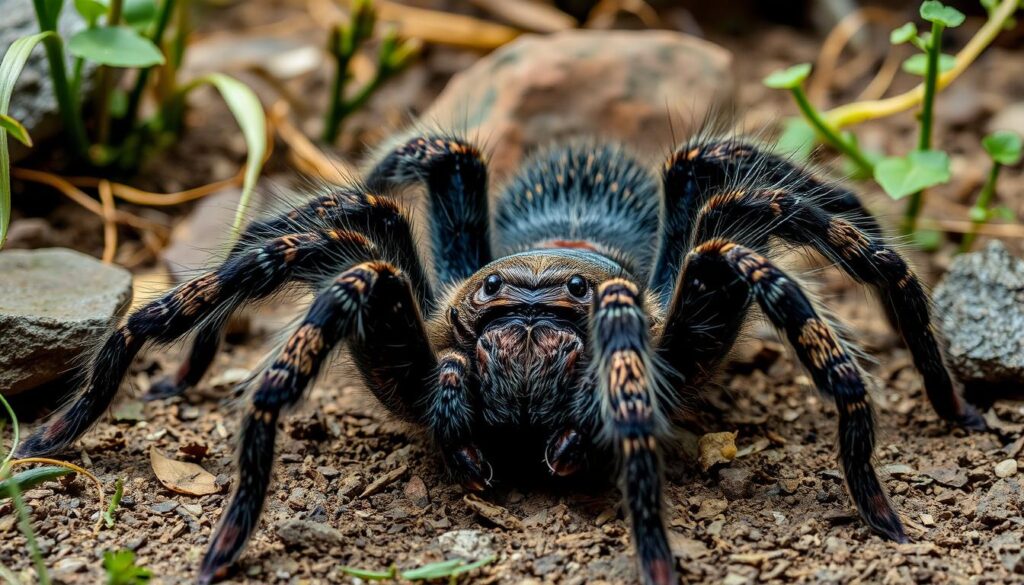
Mating Season and Escalated Aggression
During the mating season, tarantulas show more tarantula aggression. They fight for mates and defend their territory. This can lead to fierce battles and even cannibalism.
Mating season is very important for tarantulas. They go through complex rituals to find mates and protect their breeding areas. The increased tarantula aggression is a natural response to the intense competition for reproduction.
- Territorial disputes between male tarantulas can result in fierce battles, with the winners securing the right to mate with nearby females.
- Females may also display aggressive posturing and defensive behaviors to ward off unwanted suitors or protect their nests.
- In some species, tarantula aggression can escalate to the point of cannibalism, with larger or more dominant individuals consuming their rivals.
It’s important to understand tarantula aggression during mating season. This knowledge helps in handling and studying these arachnids. Proper care and environment management can reduce the risks of aggressive behavior.

By studying tarantula aggression during mating season, we can learn more about their natural behaviors. This knowledge helps in developing better care and conservation strategies for these fascinating creatures.
Molt-Related Aggression in Tarantulas
Tarantulas are fascinating creatures known for their size and striking looks. They can become aggressive during the molt process. This is when they shed their skin to grow.
The molt is a critical time in a tarantula’s life. It makes them more defensive and territorial. This can lead to fights with other tarantulas.
During the molt, tarantulas are vulnerable and exposed. They may show tarantula aggression and molt-related aggression to protect themselves. This behavior is interesting to study for both fans and scientists.
Vulnerable Stages and Defensive Posturing
As a tarantula gets ready to molt, it becomes more at risk. It may show defensive signs like raising its front legs or showing its fangs. This is to scare off predators.
The physical changes and need to stay safe can make tarantulas more aggressive during the molt. This is a key time for tarantula aggression.
Territorial Disputes and Resource Competition
Tarantulas are solitary and fiercely protect their territory and resources. When molting, they become even more aggressive in defending their space. This can lead to fights with other tarantulas.
In captivity, where space is limited, these territorial disputes can be more common. This is because there are fewer resources to go around.
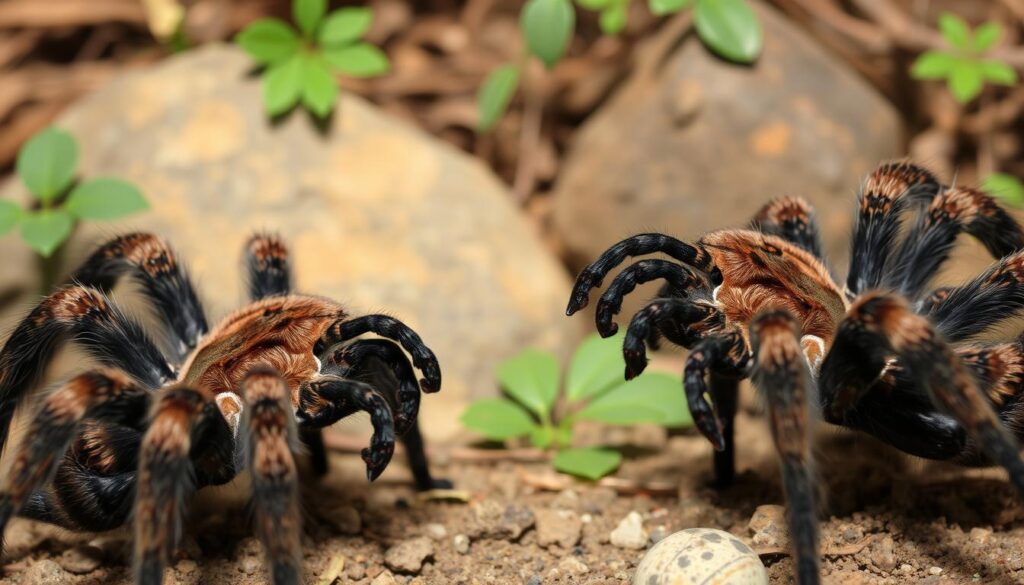
Understanding why tarantulas become aggressive during the molt is important. It helps both enthusiasts and researchers care for these spiders. Proper care and handling can reduce aggression during the molt. This keeps both tarantulas and their caretakers safe.
Impact of Captivity on Aggressive Tendencies
Keeping tarantulas in captivity can greatly affect their tarantula aggression. Limited space, competition for resources, and stress can make them more aggressive. It’s important to understand how captivity affects tarantula aggression for responsible pet care and research.
In captivity, tarantulas often lack resources and space, leading to more aggression. They compete for food, shelter, and mates. Their enclosures can also cause stress, making them more defensive.
Introducing new tarantulas or changing their environment can upset their social balance. This can lead to more aggressive tendencies. It’s crucial to plan and monitor their care to keep them safe and reduce tarantula aggression.
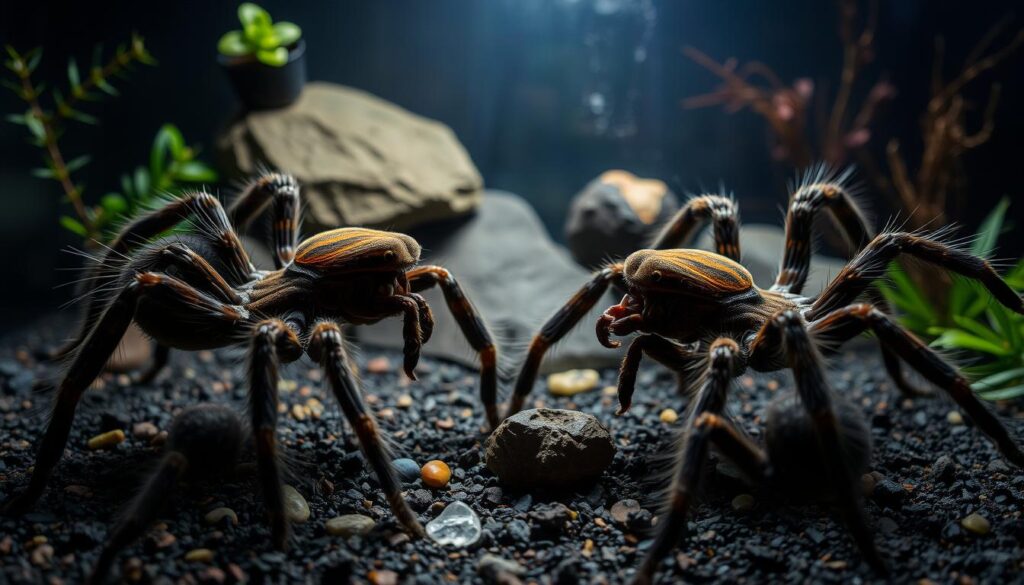
Understanding captivity’s impact on tarantula aggression helps create better environments. This reduces aggressive tendencies and improves their welfare. It also makes handling safer and supports conservation efforts for these fascinating creatures.
Conservation Efforts and Tarantula Aggression
Habitat loss and human interference threaten many tarantula species. Conservation efforts are key to protecting these amazing arachnids. Understanding tarantula aggression helps in these efforts, ensuring their safety.
Studies show 85.8 percent of U.S. residents back laws against animal cruelty. Also, 77.5 percent want limits on hunting carnivores, and 78.2 percent support banning wildlife killing contests. These numbers show growing concern for wild animals, including tarantulas.
Exploring tarantula behavior helps in conservation. By understanding their needs, we can create better habitats and manage populations. This is vital for tarantulas’ survival against environmental threats.


